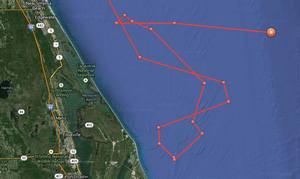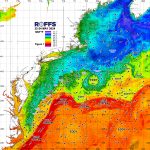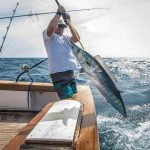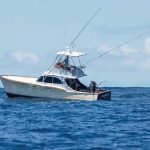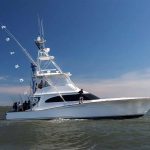Update, Jan. 19, 2014:
Katharine, a 2,300-pound great white shark tracked by the non-profit group Ocearch, appears to have moved further out into the Atlantic Ocean.
As of 6:42 a.m. Sunday, Katharine was tracked moving east at a latitude matching the Canaveral National Seashore.
Katharine was first tagged in August 2013 in Cape Cod. Her tracking history shows a steady journey to Daytona Beach, where she then began exploring Florida waters.
Her southernmost venture took her just off the beaches of Cape Canaveral Air Force Station on Jan. 11.
Update, Jan. 18, 2014:
Katharine, the great white shark who was swimming offshore of North Brevard last week, has surfaced again. This time, she’s a bit farther north, but still within a short swim of the Space Coast.
At 8:51 a.m. Saturday, the 2,300-pound great white’s satellite transmitter “pinged” off Edgewater in southern Volusia County.
Before today, Katharine’s last surface was recorded at 11:02 a.m. Sunday, Jan. 12, off the Canaveral National Seashore.
A nonprofit team’s real-time satellite tracking of the great white shark, tagged in August off Cape Cod, is opening up the mysterious travels of the often-demonized killers.
Researchers at OCEARCH, which captured, tagged and releases great white sharks aboard their 126-foot former Bering Sea crabber, have found that the sharks swim south much faster than once thought.
You can follow Katharine on Twitter. Her profile at the Twitter handle @Shark_Katharine describes a “misunderstood girl swimming around tryin’ to get some fish.”
People also can track Katharine and other satellite-tagged great white sharks on the OCEARCH website here: www.ocearch.org.
Early last year, another great white tracked by OCEARCH, Mary Lee, popped up 200 yards off Jacksonville Beach, prompting researchers to alert local authorities. But the tracking project is not intended for shark warnings. Instead, the researchers hope to reveal where these ferocious killers go and why, while raising awareness of the great white’s plight – and that of other sharks worldwide.
Other great whites tagged off Cape Cod by the same team have gained thousands of online fans. Followers watch the sharks on their serpentine journeys throughout the coastal Atlantic Ocean, sometimes seemingly a bit too close to the beach for comfort.
To catch the sharks, the researchers use large, barbless circle hooks, made of a special alloy. The hooks must degrade quickly in salt water.
The ship’s hydraulic lift hoists the sharks onto a wooden platform, where researchers gather samples and tag the sharks.
They implant tags on the sharks’ dorsal fin that can record temperature, salinity and depth.
Researchers “see” the sharks via satellite when the beasts’ dorsal fins surface and the tag’s battery gets triggered, sending a signal to the satellite.
Great whites migrate south in late fall and early winter. Scientists don’t know much about where great whites go over the long term or what they do wherever it is they go.
Like other large marine predators, great whites may migrate based on food sources, scientists say.
The researchers say they’re learning that the great whites’ movements are much more dynamic and faster than expected.
Great whites can swim in quick bursts of up to 30 mph.
The fact that great whites keep so close to shore might be scary for some swimmers, but the researchers have been quick to point out that their satellite “hits” have huge errors that can be several miles. They’re meant to measure much broader migratory movements.
No known great white shark attacks have occurred off the coast of Florida, according to the International Shark Attack File kept at the Florida Museum of Natural History.
The real-time information on the sharks could help scientists learn more about the species’ reproduction.
While great whites can live into their 70s, they face major threats from shark “finning” for soup.
Please click here for a quick analysis on the apparent overlap of the whales and sharks.
]]>
